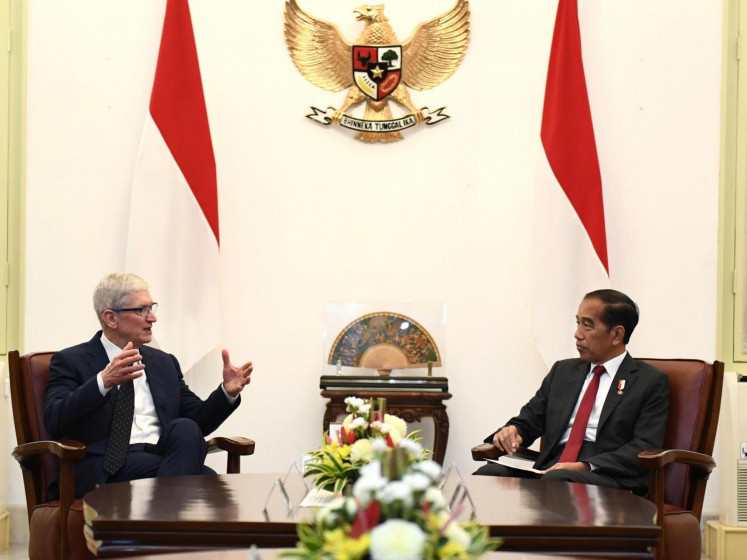Too many expected surprises
Locals try to pull their boat through a peat canal watergate, Sebangau, Central Kalimantan
Change Size

Locals try to pull their boat through a peat canal watergate, Sebangau, Central Kalimantan. WWF-Indonesia/Sebangau Project
To commemorate the 20th anniversary that produced the UN Framework Convention on Climate Change and the second year of a bilateral deal between Indonesia and Norway on the construction of REDD, The Jakarta Post’s Adisti Sukma Sawitri takes notes on progress and shortcomings in the construction.
Indonesia signed a bilateral deal with Norway, which many called a tectonic shift in the development of forest governance in Indonesia. As the third largest rain forest area in the world, the agreement means Indonesia has agreed to be a laboratory on the construction of a forest conservation mechanism, better known as REDD, as a means in the global fight to curb emission.
Norway did not simply choose Indonesia at random. President Susilo Bambang Yudhoyono announced a commitment to reduce Indonesia’s greenhouse gas emissions to 26 percent below its business-as-usual trajectory and 41 percent if financial involvement from foreign countries was made available by 2020, which was later confirmed in the UNFCCC forum in Copenhagen.
The deal includes the forest-clearing freeze and the establishment of an institutional framework to oversee REDD, which later became known as REDD+ to include conservation aspects, in Indonesia, with Central Kalimantan as a pilot project.
To stimulate the project Norway has disbursed US$30 million under the management of UN Development Program (UNDP), which provide technical advice and monitors fund disbursements.
UNDP Indonesia’s specialist on environment unit, Tomoyuki Uno said that Indonesia has spent less than half of the fund and made significant progress in the work towards the institutional frameworks of the REDD+ agency, national strategy, as well as monitoring and verification mechanisms (MRV).
“This is a huge system that has to be designed very well. For MRV, there are many issues regarding the payment mechanism and the scheme,” he said.
No projects have been made yet because it is not the goal of the agreement, he said.
“To have international recognition is so important for Indonesia [to be trusted with the fund],” he said.
Uno said the existence of a forensic audit system is important to be granted membership.
The invisible progress has left people wondering. With only the Forestry Ministry’s revisions on the moratorium map, the public has been left to wonder about the progress for the past year.
The Central Kalimantan-chapter of Indonesian Forum for the Environment (Walhi)’s director, Arie Rompas, said the situation had hardly change in the area since the implementation of the moratorium.
He cited local administration data that recorded more than 300 social conflicts in the area along 2011. Arie said 32 communities are receiving Walhi’s assistance to resolve conflicts with companies, which are mainly oil palm plantations.
“The government should implement clear geospatial data to clarify citizens’ lands,” he said.
Arie also emphasized the need to set up a conflict resolution mechanism, should land disputes occur. He said that in some cases companies simply grab land. In the case of Runtu village, West Kotawaringin, about 300 families were forced to leave their land for an oil palm companies.
“After the plantation was set up, the locals hardly became part of it and instead had to find other jobs,” he said.
A senior researcher from the Center for International Forestry Research (CIFOR), Daniel Murdiyarso, said that despite revisions, the moratorium map itself should be seen as an achievement of the government.
“In Indonesia there has never been one single forest used by all stakeholders. This map would lead to transparency of forest management in the country,” he said.
He said the moratorium would not reduce emissions, but the entire process is intended to lay ground work for better forest governance in the country.
CIFOR recorded that in previous year’s major oil palm companies had expanded at an average rate of 10,000 hectares per company per year last year while peat lands were being drained at around 100,000 hectares per year during 2000 to 2005.
“There has been a fallacy to think that peat swamps are waste lands, while studies now have found that they can keep large amounts of carbon,” he said.
The Soeharto administration launched the Penanaman Lahan Gambut (Planting peat lands) program on 1 million hectares in Central Kalimantan, in which the peat lands are drained for agriculture.
Norway’s Environment Ministry also appreciated several things occurring in the first year despite that it is “too early to conclude.”
“We could highlight the President’s formalization of Indonesia’s pledge into sectoral and provincial targets through the RAN-GRK/RAD-GRK (the National Action Plan to Reduce Green Gas Emissions) where forest and peat lands are expected to deliver as much as 89% of total national emission reductions,” said the ministry’s communication adviser Elisabeth Brinch Sand.









